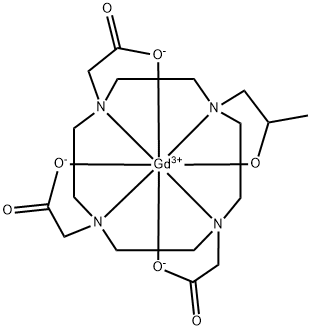CHEMICAL AND PHYSICAL PROPERTIES
| Color/Form | White solid obtained as an aggregate clump of fine needle-like micro-crystals from methanol/acetone |
|---|---|
| Melting Point | >225 °C |
| Solubility | In water, 737 mg/mL |
| Density | Osmolality (37 °C): 630 mOsM/kg water; viscosity (cP): 2.0 (20 °C), 1.3 (37 °C); density at 25 °C 1.140. /Gadoteridol injection/ |
| LogP | log Kow = -3.68 (octanol/water); logP = -1.98 (butanol/water), at pH 7 |
| Other Experimental Properties | Hydrophilic |
COMPUTED DESCRIPTORS
| Molecular Weight | 558.7 g/mol |
|---|---|
| Hydrogen Bond Donor Count | 1 |
| Hydrogen Bond Acceptor Count | 11 |
| Rotatable Bond Count | 5 |
| Exact Mass | 559.12774 g/mol |
| Monoisotopic Mass | 559.12774 g/mol |
| Topological Polar Surface Area | 154 Ų |
| Heavy Atom Count | 29 |
| Formal Charge | 0 |
| Complexity | 471 |
| Isotope Atom Count | 0 |
| Defined Atom Stereocenter Count | 0 |
| Undefined Atom Stereocenter Count | 1 |
| Defined Bond Stereocenter Count | 0 |
| Undefined Bond Stereocenter Count | 0 |
| Covalently-Bonded Unit Count | 2 |
| Compound Is Canonicalized | Yes |
PRODUCT INTRODUCTION
description
Gadoteridol provides contrast enhancement of the brain, spine and surrounding tissues resulting in improved visualization (compared with unenhanced MRI) of lesions with abnormal vascularity or those thought to cause a disruption of the normal blood brain barrier. Gadoteridol can also be used for whole body contrast enhanced MRI including the head, neck, liver, breast, musculoskeletal system and soft tissue pathologies. n MRI, visualization of normal and pathological brain tissue depends in part on variations in the radiofrequency signal intensity that occur with changes in proton density, alteration of the T1, and variation in T2. When placed in a magnetic field, gadoteridol shortens the T1 relaxation time in tissues where it accumulates. Abnormal vascularity or disruption of the blood-brain barrier allows accumulation of gadoteridol in lesions such as neoplasms, abscesses, and subacute infarcts.
